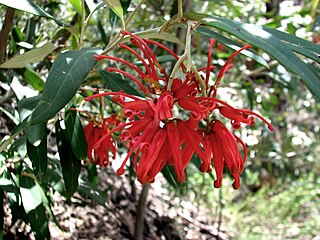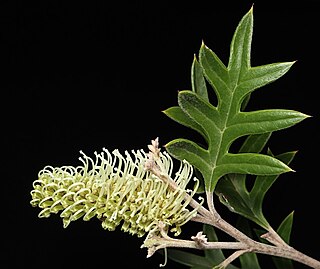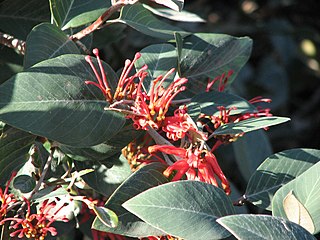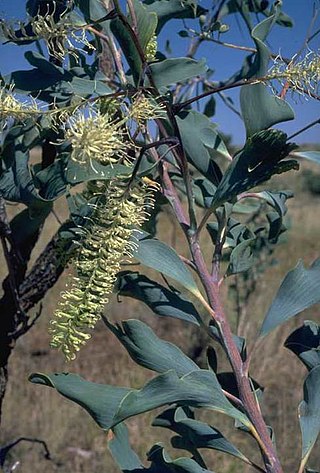
Henry Richard Enfield is an English comedian, actor, writer and director. He is known in particular for his television work, including Harry Enfield's Television Programme and Harry & Paul, and for the creation and portrayal of comedy characters such as Kevin the Teenager, Loadsamoney, Smashie and Nicey, The Scousers, Tim Nice-But-Dim and Mr. "You Don't Want to Do It Like That".

The London Borough of Enfield is a London borough in North London. It borders the London boroughs of Barnet to the west, Haringey to the south, and Waltham Forest to the southeast. To the north are the districts of Hertsmere, Welwyn Hatfield and Broxbourne, and to the east is Epping Forest District in Essex. The local authority is Enfield London Borough Council. Enfield's population is estimated to be 333,794; the main towns in the borough are Edmonton, Enfield, Southgate and Palmers Green. Enfield is the northernmost London borough.

Grevillea, commonly known as spider flowers, is a genus of about 360 species of evergreen flowering plants in the family Proteaceae. Plants in the genus Grevillea are shrubs, rarely trees, with the leaves arranged alternately along the branches, the flowers zygomorphic, arranged in racemes at the ends of branchlets, and the fruit a follicle that splits down one side only, releasing one or two seeds.

Grevillea victoriae, also known as royal grevillea or mountain grevillea, is a species of flowering plant in the family Proteaceae and is endemic to mountainous regions of south-eastern continental Australia. It is an erect to spreading shrub with elliptic to lance-shaped leaves, and pendulous clusters of red to orange flowers.

Grevillea barklyana, also known as gully grevillea or large-leaf grevillea, is a species of flowering plant in the family Proteaceae and is endemic to Western Gippsland in Victoria, Australia. It is an erect shrub or small tree, with mostly pinnatifid leaves with two to eleven lobes, and whitish pink to fawn flowers.

Grevillea microstegia, commonly known as Mount Cassell grevillea, is a species of flowering plant in the family Proteaceae and is endemic to Victoria in Australia. It is a prostrate to low-lying or straggling shrub with deeply divided leaves, the end lobes triangular, and toothbrush-shaped clusters of reddish-brown flowers with a red style.

Grevillea steiglitziana, also known as Brisbane Range grevillea, Brisbane Ranges grevillea or Steiglitz grevillea, is a species of flowering plant in the family Proteaceae and is endemic to Victoria, Australia. It is a low, spreading shrub with pinnatifid to pinnatipartite leaves, and greenish-brown flowers with a red style.

Forty Hall is a manor house of the 1620s in Forty Hill in Enfield, north London. The house, a Grade I listed building, is today used as a museum by the London Borough of Enfield. Within the grounds is the site of the former Tudor Elsyng Palace.

Grevillea celata, commonly known as Nowa Nowa grevillea or Colquhoun grevillea, is a species of flowering plant in the family Proteaceae and is endemic to a restricted part of Victoria in Australia. It is an erect and open to low, dense shrub with oblong, broadly elliptic or linear leaves, and red and yellow, or red, white and apricot-coloured, sometimes all yellow flowers.

Grevillea bedggoodiana, commonly known as Enfield grevillea, is a species of flowering plant in the family Proteaceae and is endemic to a restricted area near Ballarat in Victoria, Australia. It is a prostrate to low-lying shrub with coarsely serrated, egg-shaped to oblong leaves and green and pink flowers.

Pine Mountain is a gigantic monolith, said to be 1.5 times bigger than Uluru, situated in the Burrowa-Pine Mountain National Park in Australia.

Grevillea gariwerdensis is a species of flowering plant in the family Proteaceae and is endemic to Grampians National Park in Victoria, Australia. It is a shrub with more or less linear to narrowly oblong leaves, and white to pink flowers with brownish hairs.

Grevillea alpivaga, also known as buffalo grevillea, is a species of flowering plant in the family Proteaceae and is endemic to a restricted area of Victoria, Australia. It is a shrub with crowded, linear leaves and pale green creamy-white flowers.

Grevillea dimorpha, commonly known as flame grevillea or olive grevillea, is a species of flowering plant in the family Proteaceae and is endemic to the Grampians National Park in Victoria, Australia. It is an erect to spreading shrub with elliptic to linear or egg-shaped leaves with the narrower end towards the base, and groups of bright red flowers.

Grevillea willisii, commonly known as Omeo grevillea or rock grevillea, is species of flowering plant in the family Proteaceae, and is endemic to the eastern highlands of Victoria, Australia. It is a spreading to erect shrub with pinnatipartite leaves, the end lobes broadly triangular to oblong and sometimes sharply pointed, and dense clusters of greenish-white to fawn-coloured flowers with a white to cream-coloured style.

Grevillea burrowa, commonly known as Burrowa grevillea, is a species of flowering plant in the family Proteaceae and is endemic to a restricted area of Victoria, Australia. It is a spreading shrub with oblong to egg-shaped leaves, and clusters of reddish-pink flowers.
Mount Selma is a mountain located to the north-east of Aberfeldy in Victoria, Australia. Its peak is 1463 metres above sea level. The headwaters of the Aberfeldy River rise on its southerly slopes.

Mount Gibbo is a mountain in the Australian Alps. It is 38 kilometres to the north-east of Benambra in Victoria, Australia and lies within the Mount Gibbo Natural Features and Scenic Reserve managed by Parks Victoria. The reserve, which covers 1493.1 hectares, was established in 1979. On the northern side of the mountain, Ordovician sediments are exposed on the steep slopes. Surrounding peaks include Mount Pinnibar to the north, Mount Hope to the south-east and Mount Sassafras to the west. Plant species found in the reserve include the rare Alpine Phebalium and the endangered Kosciuszko Grevillea. The area was extensively burned by a bushfire in 2003.
Mount Elizabeth is a mountain to the east of Tambo Crossing in East Gippsland, Victoria, Australia. It lies within the Mount Elizabeth Nature Conservation Reserve managed by Parks Victoria. The reserve, which covers 5,234 hectares, was established in 1984. The reserve is the only known location where the endangered plant species leafy nematolepis occurs. Other rare or vulnerable plant species found in the reserve include Tullach Ard grevillea, outcrop guinea-flower, Mount Elizabeth hovea, monkey mint-bush and leafless pink-bells. Fauna species of note include the lace monitor, yellow-tailed black cockatoo and gang-gang cockatoo.

Grevillea dimidiata, also known as the caustic bush or willings tree, is a species of flowering plant in the family Proteaceae and is endemic to northern Australia. It is a shrub or small tree with glabrous, more or less sickle-shaped, curved leaves with wavy edges, and cylindrical groups of greenish-white to cream-coloured flowers.


















